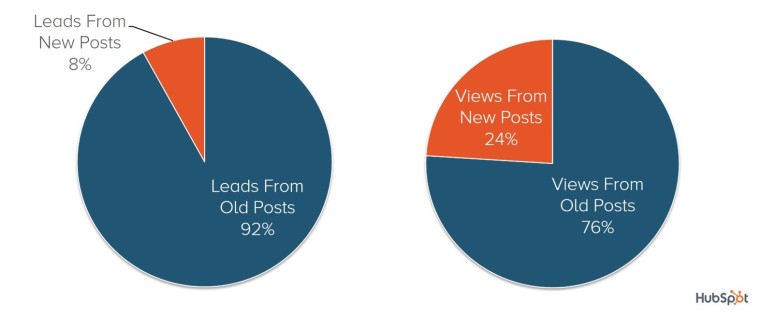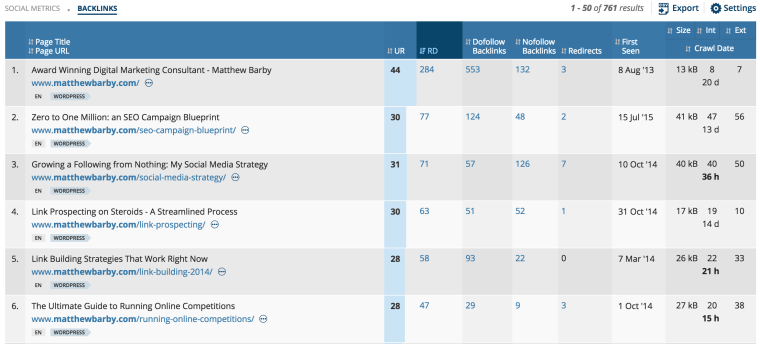Not every piece of content ends up ranking well in the search engines. Over 2.5 million blog posts are published every day and I’d imagine that 90% of those get next to no traffic to them at all.
I’ve previously worked on big content campaigns where it just hasn’t gone as planned. The natural reaction of most companies is to tear down what they’ve created and start again. This is just answering the problem with more volume.
I’m here to say to those people who you’re doing it wrong.
The Decision to ‘Reoptimize’
One thing to bear in mind is that it usually takes a while for your content to rank well for a specific keyword you’re targeting in the search engines. This is particularly relevant if you’re going out a highly competitive keyword.
I spent a lot of time analyzing the content on the HubSpot blog to see how long it takes us to start really bringing through organic traffic for a post once it’s published. I found that it’s not until at least 3-4 months (on average) that we really start to see a lot of traffic coming from to our content.

The above chart is from a content study that my colleague, Pam Vaughan, put together across our blog. She found that 76% of the visits to our blog content came from posts that had been published before that month.
Whenever you’re evaluating the ‘success’ of a piece of content, at least from an organic search point of view, bear this in mind. You should set some realistic timescales for measuring success before you decide that something’s failing.
3 Options for Reoptimization
Instead of answering the problem of underperforming content with more content, I always try to see if there’s a way that I can tweak what I already have to improve performance. This approach is both quicker and less resource-heavy so it’s always worth considering before doing anything drastic.
If I’ve decided that I need to look into reoptimizing some of my underperforming content so that it ranks better in the search engines, I consider three different routes:
- Internal link boosting
- Content consolidation
- Create of cluster content
I’ll walk you through the details of each approach.
1. Internal Link Boosting
Backlinks are an incredibly important piece of the SEO puzzle. Without a solid volume of backlinks, your content is highly unlikely to rank for any competitive keywords. When most people think about backlinks, they think about ones from external websites, but internal links are just as important.
Pushing an internal link from an authoritative page on your website through to an underperforming page can sometimes have a substantially positive effect. This is particularly effective within websites that generally have high domain authority.

Using a tool like Ahrefs, you can go through and find the most linked-to pages across your website. If it’s viable to place an internal link to your underperforming content from one of these pages then it’s likely to have the most impact.
As well as authority, you want to think about relevance. Are there any pages on your website that are particularly relevant to your underperforming content? If so, these are the perfect pages to place even more internal links – you can often include exact match anchor text from these links too.
The more authoritative and relevant internal links you can point to your underperforming content, the better.
2. Content Consolidation
This route is my favorite and it’s often overlooked. In short, it involves taking two similar underperforming pieces of content and redirecting one into the other to make one higher performing page.
I’ve used this technique on countless occasions to squeeze more traffic out of my existing content.
One situation in particular that it comes in handy for is dealing with keyword cannibalization issues. If you’ve not heard of what keyword cannibalization is, here’s a brief explanation:
Keyword cannibalization is where you have two or more webpages that are covering semantically similar topics. As a result, they end up ranking in the search engines for the same keyword and compete with themselves for positions.
A lot of people think it’s a good idea to have multiple pages from your website ranking for the same keyword. Surely that’ll just generate more traffic? The answer is yes and no.
Let me explain with an example…
Let’s say that you have two articles ranking for the same keyword. Both of them are on page 1 of Google but one is position 5 and the other is position 6.

For the purposes of the example, we’ll assume that the keyword in question is searched for 20,000 times each month.
Under that assumption we could expect the following number of visits for each position on page 1:
- 6,000
- 3,200
- 2,000
- 1,400
- 1,000
- 600
So if your content is ranking at both #5 and #6 you could expect, on average, around 1,600 visits.
Now, if instead you were to take the piece of content ranking at #6 and redirect it into the content at #5 you’d be combining all of the backlinks of those pages and likely improving the overall rankings significantly.
Let’s take a modest estimate that you jump the one article up to position 3. You’re now bringing through 2,000 visitors – a 20% increase.
All of this for what takes less than a minute to actually execute.
One thing to just be aware of here is that once you’ve redirected your page, nobody will be able to access it. If you’re running any paid or social campaigns to drive traffic to the page then it will be passed through to the new page so just make sure you do your due diligence before pushing the button.
3. Create Cluster Content
The way that I map out all of my content campaigns is within topic clusters. If you’re unsure of what I mean by a topic cluster, here’s a brief explanation:
A topic cluster is a collection of semantically relevant content that individually cover smaller themes within an overarching topic.
Any big piece of content that I’m targeting against hyper-competitive search terms will be marked as pillar content. Then a range of content will be created covering subtopics related to the main pillar that internally link to it.

The above diagram is an example of a topic cluster for SEO. The more related content surrounding the main topic, the stronger relevance you’re building around the keywords within the search engines.
With this in mind, an approach that I take with underperforming content is to create more related cluster content that links back into it. This can be housed on your own website or in the form of an external guest post; either way you’re firing through more relevant links to your underperforming content to give it a boost.
This is a much more strategic way to approach content creation and can help deliver a positive user experience across your content too.
Conclusion
A far too frequent response to underperforming content is to tear it all down and start again. This is such an ineffective approach and a huge waste of time.
Whether you’re going to build out some new content to give your underperforming piece an added push (cluster content), you’re building through some fresh internal links from top content on your site, or if you’re planning on consolidation overlapping content; there’s always a way to get more out of what you’ve already created. You just need to get a little creative!
No comments:
Post a Comment